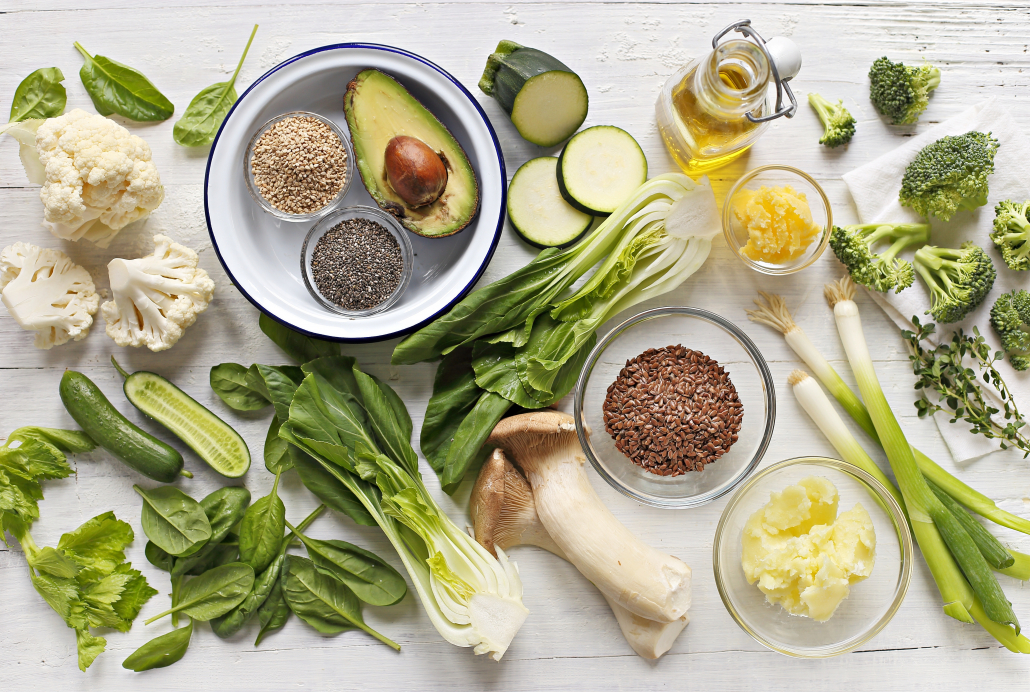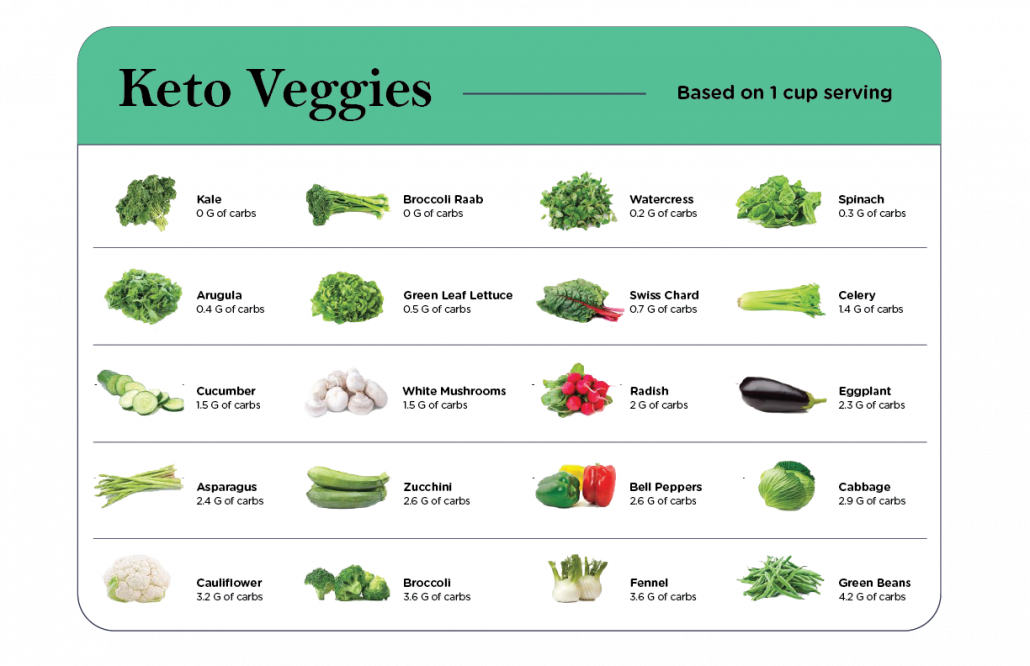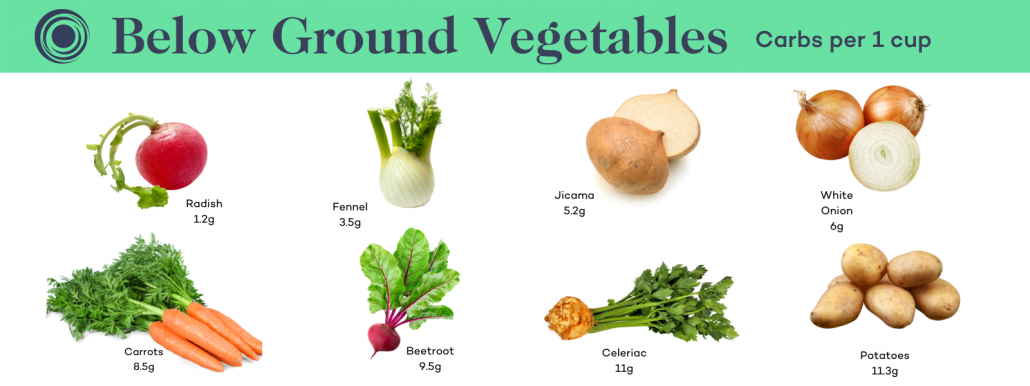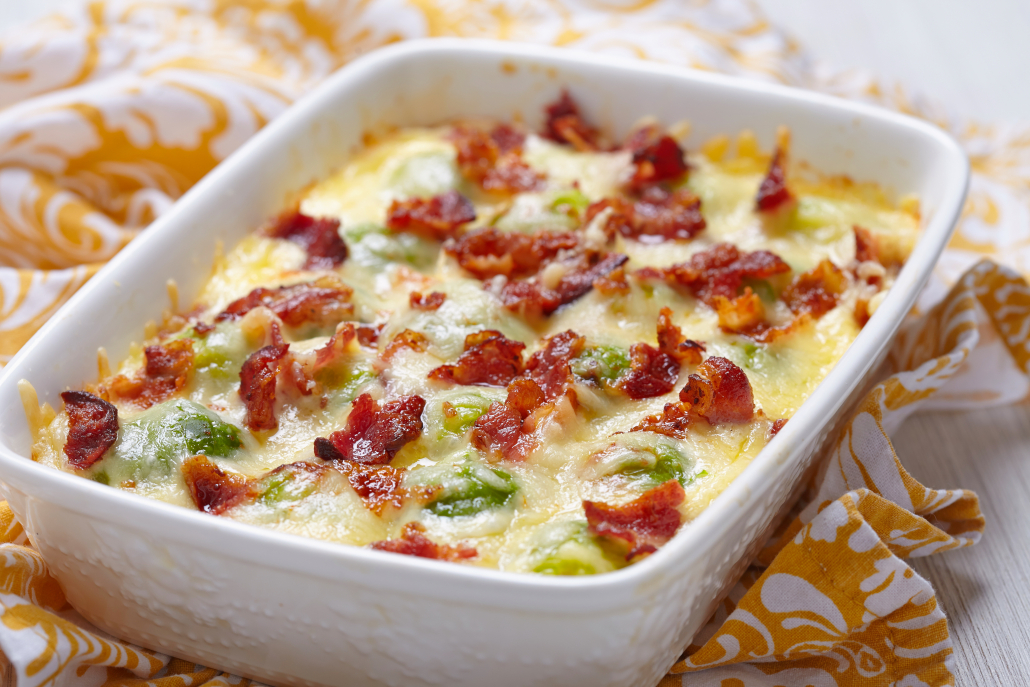We include products in articles we think are useful for our readers. If you buy products or services through links on our website, we may earn a small commission.
Keto Vegetables: Your Guide to Low-Carb Veggies

When consumed in moderation, low-carb keto vegetables can provide a good source of micronutrients like vitamin C, and alkalinity to your keto protocol. And they play a key role in vegetarian keto, vegan keto, and Mediterranean keto diets
Yet, keto means low-carb and all vegetables are mostly carbohydrates and water. So it’s important to be able to sort out high-carb vs. low-carb vegetables.
It’s also important to consider that many low-carb vegetables contain surprisingly high amounts of plant toxins like phytic acid, saponins, and phytohormones. These antinutrients can cause issues including vitamin deficiencies, hormone imbalances, and leaky gut.
Unfortunately, most guides to keto veggies give the simple rule of choosing above ground veggies for their low carbs. Yet, these are often the veggies with the most toxins and antinutrients. While below ground veggies like sweet potatoes have lower toxin levels, but more carbs.
When choosing your keto veggies, there’s more than just the carb count to consider.
In this article, we’ll explore the best veggies for keto, and others to steer clear of while taking into account their toxin and antinutrient concerns and how to reduce them.
Table of Contents
What is Keto?
Keto is a high-fat, low-carb, moderate-protein diet. Its clinically studied benefits include weight loss, reduced inflammation, increased energy, enhanced clarity, freedom from carb addiction, and more. 1
Keto requires cutting carbs to less than 25 grams per day, at least when starting out. Restricting carbs and boosting fat switches your body from relying on carbs for energy, to breaking down fat into ketones.
When the levels of ketones in your blood become elevated, you’re in ketosis.
Once your body becomes keto adapted, studies show that you may be able to increase your carbs by up to 60 grams per day. [1] This means the opportunity to add more keto vegetables.
Let’s start off with a look at the most popular and lowest carb keto vegetables
Above Ground Keto Vegetables

Above ground vegetables, as you might expect, are veggies that grow above ground. Some “veggies” on this list are actually fruits, but function primarily as vegetables so they are included in this list. Some of the best keto veggies are:
- Arugula
- Romaine Lettuce
- Spinach
- Avocado (technically a fruit)
- Asparagus
- celery
- Cucumber (technically a fruit)
- Eggplant
- Tomato (technically a fruit)
- Zucchini
- Cabbage
- Cauliflower
- Kale
- Broccoli
- White Mushrooms
- Green beans
- Brussel sprouts
- watercress
- swiss chard
- Bell Pepper (green/yellow/red)
You’ll note that tomatoes and peppers, fruits that are commonly misidentified as vegetables, are also on this list. Tomatoes can boost carbs pretty quickly, so should be used seldomly.
Keto Root Vegetables

When it comes to keto-friendliness, keto root vegetables are a different story. Most of them are too high in carbohydrates to be routinely compatible with the keto diet. Some can make the cut, while others can be enjoyed once in a while, or as part of the cyclical ketogenic diet.
Above-ground vegetables include:
- Sweet potatoes
- Potatoes
- Celeriac
- Rutabaga
- Beetroot
- Parsnips
- Onions
- Carrots
- Fennel
- Radishes
- Jicama
Below ground veggies often contain more soluble fiber while providing less insoluble fiber than above ground veggies. Despite the myths that insoluble fiber is good for your gut, studies show that just the opposite may be true.
This means that you may want to limit your keto vegetable intake to root vegetables once you become keto adapted and able to occasionally tolerate more carbs.
This way of eating is in alignment with evolutionary dietary patterns. Recent research reveals that for nearly 2 million years our cavemen ancestors ate mostly meat along with some roots and fruits.
Essentially, none of the above ground vegetables listed here even existed. They’ve all been recently bred from nearly inedible plants.
You can learn more about fiber myths and truths here.
Top 8 Keto Vegetables
Though root vegetables may be the lowest-toxin food, they do cut into your carb allowance pretty quickly, which is why none of them are featured in our top 10 keto vegetables. These include:
- Asparagus
- Avocado
- Brocolli
- Brussel sprouts
- Cabbage
- Cauliflower
- Kale
- Zucchini
1. Asparagus
Asparagus is a savory, nutritious, and ultra-low-carb veggie. It’s also rich in antioxidants and other micronutrients.
Nutrition breakdown
Asparagus macronutrients
| 1 cup asparagus | |
| Calories | 27 |
| Total fat | 0.2 grams |
| Saturated fat | 0.1 grams |
| Trans fat | 0.0 grams |
| Cholesterol | 0 milligrams |
| Sodium | 3 milligrams |
| Carbohydrates | 5 grams |
| Sugar | 2.5 grams |
| Protein | 2.9 grams |
Asparagus micronutrients
| Vitamin C | 12% |
| Iron | 16% |
| Magnesium | 4% |
| Vitamin B6 | 5% |
| Calcium | 3% |
Toxins/Antinutrients
Asparagus is high in purines, which may be problematic for people who are predisposed to gout. On the bright side, asparagus is among the lowest-lectin vegetables. [2]
How to prepare
Asparagus and fatty sauces are a match made in culinary heaven. Boil your asparagus until soft, then fry it in healthy keto fats like coconut oil, butter, and ghee . When it’s almost ready, add a homemade bearnaise sauce to make a meal of it!
2. Avocado
Avocado is technically a fruit — but functionally speaking, it’s one of the healthiest and keto-friendliest vegetables out there. Avocado is rich in healthy monounsaturated fats that have been correlated with increased insulin sensitivity and reduced inflammation. [3]
Nutrition Breakdown
Avocado macronutrients
| 1 avocado | |
| Calories | 322 |
| Total fat | 29 grams |
| Saturated fat | 4.3 grams |
| Trans fat | 0 grams |
| Cholesterol | 0 milligrams |
| Sodium | 14 milligrams |
| Carbohydrates | 17 grams |
| Net Carbs | 4 grams |
| Sugar | 1.3 grams |
| Protein | 4 grams |
Avocado Micronutrients
| Vitamin C | 38% |
| Iron | 7% |
| Magnesium | 16% |
| Vitamin B6 | 30% |
Toxins/Antinutrients
Avocado’s pit and skin contain a toxin called persin, but thankfully, we humans are the only mammal that can tolerate small amounts of persin without problem. [4]
Avocado may also negatively effect people who are allergic to latex. In fact, 30-50% of people who are allergic to natural rubber latex, are also hypersensitive to some to certain fruits, especially avocado.5
How to prepare
For people not subject to latex fruit syndrome, avocado doesn’t need any special preparation and can be eaten fresh. We recommend it as a topping to scrambled eggs.
3. Broccoli
Broccoli is high in vitamin C, sulforaphane, and other aging-fighting antioxidants. [5]
Broccoli is also versatile. If you’re new to keto, it makes a great substitute for pasta, beans, or other starches.
Nutrition Breakdown
Broccoli Macronutrients
| Calories | 266 |
| Total fat | 9.9 grams |
| Saturated fat | 2.6 grams |
| Trans fat | 0.0 grams |
| Cholesterol | 296.1 milligrams |
| Sodium | 126.6 milligrams |
| Carbohydrates | 3 grams |
| Net Carbs | 3 grams |
| Sugar | 0 grams |
| Protein | 39 grams |
Broccoli micronutrients
| Vitamin C | 1% |
| Iron | 59% |
| Magnesium | 11% |
| Phosphorus | 38% |
| Zinc | 42% |
| Copper | 46% |
| Thiamine | 92% |
| Riboflavin (B2) | 158% |
| Niacin | 76% |
| Vitamin B6 | 44% |
| Vitamin B12 | 143% |
Toxins/antinutrients
Broccoli contains small amounts of goitrogens, which are natural thyroid inhibitors. [6] If you’re experiencing thyroid issues it may be best to choose a different keto veggie.
How to prepare
Steaming broccoli is a great way to minimize its antinutrient profile. Once steamed, load your broccoli with cheese and tallow to achieve your macronutrient ratios.
4. Brussels Sprouts
Brussel sprouts are as keto-friendly as they are delicious. While slightly higher in carbs than other above-ground veggies, nearly half of these carbs come in the form of fiber, so they don’t count against your net carb intake.
Nutrition Breakdown
Brussel sprouts macronutrients
| Brussel sprouts (1 cup) | |
| Calories | 38 |
| Total fat | 0.3 grams |
| Saturated fat | 0.1 grams |
| Trans fat | 0.0 grams |
| Cholesterol | 0 milligrams |
| Sodium | 22 milligrams |
| Carbohydrates | 8 grams |
| Net Carbs | 5 grams |
| Sugar | 1.9 grams |
| Protein | 3 grams |
Brussel sprouts micronutrients
| Vitamin C | 124% |
| Iron | 6% |
| Magnesium | 5% |
| Vitamin B6 | 10% |
Toxins/antinutrients
Like many other cruciferous vegetables, brussel sprouts contain large amounts of goitrogens and nitriles. These two types of antinutrients have anti-thyroid properties. [7] Some nutritionists speculate that occasional goitrogen intake has a hormetic effect — i.e, what doesn’t kill you makes you stronger — but more research is needed on this topic. [8]
How to prepare
Studies show that cooking Brussel sprouts slashes the bioavailability of its goitrogens in half. So be sure to cook your brussel sprouts well, frying them in butter or ghee. or baking them into a fat-filled bacon loaded casserole are winning combos. Fermentation also reduces the antinutrient profile. [9]

5. Cabbage
Cabbage is another keto-friendly crucifer that really transforms when properly prepared.
Rich in vitamin C and other antioxidants, cabbage is also a good choice for those who are watching their calories (not that you’ll likely need to on a keto diet). Cabbage was once thought of as a type of cure-all — throughout the middle ages it was recommended for everything from chronic pain to snake bites. [10]
Nutrition breakdown
Cabbage macronutrients
| Cabbage (1 cup shredded) | |
| Calories | 17 |
| Total fat | 0.1 grams |
| Saturated fat | 0.0 grams |
| Trans fat | 0.0 grams |
| Cholesterol | 0 milligrams |
| Sodium | 13 milligrams |
| Carbohydrates | 4.1 grams |
| Net Carbs | 2 grams |
| Sugar | 2 grams |
| Protein | 0.9 grams |
Cabbage micronutrients
| Vitamin C | 42% |
| Iron | 1% |
| Magnesium | 2% |
| Vitamin B6 | 5% |
Toxins/Antinutrients
Like other cruciferous vegetables, cabbage is high in goitrogens that can inhibit thyroid function and increase one’s risk of thyroid cancer. [11]
How to prepare
The best way to prepare cabbage is probably also the most traditional way: by fermenting it into sauerkraut.
Fermentation reduces both goitrogen and nitrile content and introduces plenty of beneficial enzymes. [12] Cabbage is also great when slow cooked, perhaps as part of a homemade bone broth.
6. Cauliflower
Cauliflower is one of the most functional keto veggies. It provides a worthy replacement for carb-based dishes like rice or pasta.
With its alkalizing pH, an array of antioxidants, and high vitamin C content, cauliflower is also especially nutritious.
Nutrition breakdown
Cauliflower macronutrients
| Cauliflower (1 head) | |
| Calories | 146 |
| Total fat | 1.6 grams |
| Saturated fat | 0.4 grams |
| Trans fat | 0.0 grams |
| Cholesterol | 0 milligrams |
| Sodium | 176 milligrams |
| Carbohydrates | 29 grams |
| Net Carbs | 17 grams |
| Sugar | 11 grams |
| Protein | 11 grams |
Cauliflower micronutrients
| Vitamin C | 472% |
| Iron | 13% |
| Magnesium | 22% |
| Vitamin B6 | 55% |
| Calcium | 12% |
Toxins/antinutrients
Cauliflower’s status as a cruciferous vegetable means it contains some goitrogens along with sulforaphane. [13]
Sulforaphane can have an antibiotic effect that may help reduce bacterial, fungal, and viral infections in the intestines. Yet it exists in the first place as a natural pesticide that kills predatory bugs. This makes it a double-edged sword capable of attacking our mitochondria and causing cellular damage to our bodies. Though researchers like to sing the praises of this plant toxin, it’s likely best enjoyed in small doses.
How to prepare
Cauliflower can be delicious whether you keep things simple and steam it use it as a keto pizza crust!
7. Kale
Kale is slightly higher in carbs than other leafy greens, though most of its carbs come from fiber. Yet kale is also versatile and fairly nutritious, providing a high amount of vitamin C.
Nutrition breakdown
Kale macronutrients
| Kale (1 cup) | |
| Calories | 33 |
| Total fat | 0.6 grams |
| Saturated fat | 0.1 grams |
| Trans fat | 0.0 grams |
| Cholesterol | 0 milligrams |
| Sodium | 25 milligrams |
| Carbohydrates | 6 grams |
| Net Carbs | 3 grams |
| Sugar | 0 grams |
| Protein | 2.9 grams |
Kale micronutrients
| Vitamin C | 134% |
| Iron | 5% |
| Magnesium | 7% |
| Vitamin B6 | 10% |
| Calcium | 10% |
Toxins/antinutrients
Kale contains oxalates that can cause inflammatory symptoms and even kidney failure in some people. So make sure to cook your kale to reduce these compounds!
How to prepare
Bake it into kale chips, or sauté it in butter, tallow, or ghee. To avoid oxalate-cookware interactions be sure to cook your kale in glass. [14]
8. Zucchini
Zucchini is a low carb, low calorie, highly satiating keto veggie. Zucchini is delicious almost regardless of how you prepare it — it can be baked into bread, grated into salad, and more.
Nutrition breakdown
Zucchini macronutrients
| 1 zucchini | |
| Calories | 33 |
| Total fat | 0.6 grams |
| Saturated fat | 0.2 grams |
| Trans fat | 0.0 grams |
| Cholesterol | 0 milligrams |
| Sodium | 16 milligrams |
| Carbohydrates | 6 grams |
| Net Carbs | 4 grams |
| Sugar | 4 grams |
| Protein | 2.4 grams |
Zucchini micronutrients
| Vitamin C | 58% |
| Iron | 3% |
| Magnesium | 8% |
| Vitamin B6 | 15% |
| Calcium | 3% |
Toxins/Antinutrients
Like most other plants in the gourd family, zucchini is pleasantly low in antinutrients.
How to prepare
One of the best ways to enjoy zucchini is also the simplest: just cut it into slices and add some olive oil, salt, or pepper. And if you’re feeling more creative, you can always try your hand at making zucchini bread or pasta.
Keto Veggies FAQ
Are Carrots Keto?
While carrots are high in carbs, most of these carbs take the form of fiber. Some experts believe that carrot fiber is uniquely antibacterial. [15] Perhaps it’s no surprise that the traditional french diet includes carrot and olive oil salads prior to meals.
If you enjoy carrots, you don’t have to cut them out entirely — just be sure to enjoy them in moderation.
Are Green Beans Keto?
Yes, green beans are keto. A half-cup serving contains just 2 grams of net carbs.
Is Broccoli Keto?
Yes, broccoli is low-carb and keto-friendly. Just beware of the sulforaphane content and be sure to cook your broccoli.
Is Squash Keto?
Squash contains more starchy carbohydrates than most vegetables, but small amounts of it can fit into your keto diet with ease.
Is Corn Keto?
Corn is relatively high in carbs — and also high in antinutrients. We don’t recommend corn on the keto diet.
Is Yellow Squash Keto?
Yes, yellow squash is indeed keto-friendly. A full cup of it contains only 0.4 grams of net carbs.
Why You May Want to Limit Veggies on Your Keto Diet
Even low-carb, keto-friendly vegetables aren’t without their faults. Eating an excess of these veggies can provide your body with too many plant toxins and too much fiber.
Plant Toxins and Antinutrients
A diet high in certain raw and cooked vegetables can lead to net nutrient loss. That’s because the antinutrients in these veggies block nutrient absorption — including the absorption of their own nutrients and the nutrients from other foods.
That’s why, for instance, only 1.7% of the iron in cooked spinach is absorbed by your body. The popeye-spinach connection is but a myth. 3
Excess Fiber
Contrary to what you may have heard, fiber isn’t universally beneficial. Eating too much fiber is arguably worse than eating none. Studies show that excess fiber sits in the gut and ferments over time, which can lead to SIBO or other bacterial overgrowths.
High fiber intake has even been correlated with increased risks of colon cancer. [16] See our Fiber Myths article for a more in-depth look at this topic.
Keto Vegetables: The Bottomline
Vegetables, even the low-carb variety are mostly carbs and water. And they also contain toxins and antinutrients that can negatively affect your health.
Yet, when consumed in moderation, low-carb keto vegetables can provide a good source of micronutrients like vitamin C, and alkalinity to the keto diet.
Perhaps just as importantly, keto veggies offer some variety to your meals. Just don’t neglect the fact that keto veggies are best used as a vehicle for keto fats.





















